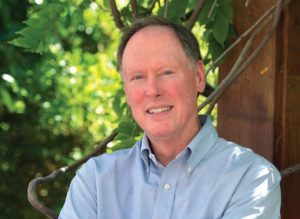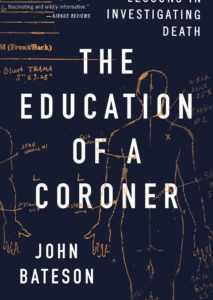Today SevenPonds has the pleasure of speaking with John Bateson, the former executive director of a nationally-certified crisis intervention and suicide prevention center in the San Francisco Bay Area. John is a recognized expert in suicide prevention, and has written several critically acclaimed books on the subject, including “The Last and Greatest Battle: Finding the Will, Commitment and Strategy to End Military Suicides” and “The Final Leap: Suicide on the Golden Gate Bridge.” More recently, he penned the book, “The Education of a Coroner,” which explores the career of former Marin County Coroner Kenneth Holmes.
Note: This interview has been edited for length and clarity.

Credit: Simon & Schuster, Canada
Kathleen Clohessy: I understand you worked on a number of college campuses as a counselor. What are your thoughts on the increasing number of young people who are either dying by suicide or making suicide attempts? Some experts blame social media and peer pressure/bullying. Do you agree,or do you think there are other factors in play?
John Bateson: In some respects, cyber bullying is more serious than physical bullying. The ability of bulliers to use social media to spread rumors or send hurtful texts, post nasty comments, create fake profiles, or post embarrassing pictures and videos means that someone can be bullied anytime, day or night, often when the victim is alone. In addition, comments and images can be posted anonymously and distributed rapidly to a large number of people. The shame and embarrassment a victim feels from being physically bullied are magnified when he or she is cyber bullied because it seems like everyone knows it.
Peer pressure is another source of stress among adolescents, and often leads to bad choices. Alcohol, for instance, can make a young person who already is depressed more so while decreasing inhibitions and providing “liquid courage” to act on poorly thought-out plans.
That said, one of the strongest risk factors for suicides in adolescents is childhood trauma, particularly abuse. The longer the abuse lasts, the more severe it is, and the closer the relationship between the abuser and the victim, the greater the risk. Childhood abuse often leads to low self-esteem, drug use, alcoholism, delinquent behavior, and detachment from others — all tied to suicide risk.
Kathleen: The U.S. has seen a big uptick in suicides as well as deaths from drugs and alcohol-related causes over the last decade. Do you have any thoughts on why this is happening?
John: What’s interesting from a sociological perspective is that one of the main factors related to suicide historically has been unemployment. Yet the current unemployment rate is low while the suicide rate has increased considerably.
Consumption of alcohol, opioids, and hard drugs like heroin has skyrocketed in recent years, and this increases the risk of suicide. The current war in the Middle East has lasted longer than any war in U.S. history, and is taking an increasing toll on service members and their families, especially those who experience multiple deployments. In addition to cyber bullying, widespread use of social media is leading people to share personal information with near strangers, which isn’t particularly healthy. Moreover, if everyone else appears to be having a good time and you’re not, it can contribute to depression.
Last, and perhaps most important, we’ve become a nation of gun owners. It’s no coincidence that the states with the highest suicide rates — Nevada, Alaska, Idaho, Arizona, and New Mexico — have the largest proportion of males and the most liberal gun laws. Access to lethal means often is within easy reach.
Kathleen: What do you think we as a society can do to turn the tide, which is obviously moving in the wrong direction?
John: Research shows that the two most effective ways to prevent suicide are to restrict access to lethal means and train physicians, counselors, and mental health professionals to identify people at risk of suicide and intervene effectively.

Credit: troubledteens.com
Regarding the first, suicide barriers can be erected at jump sites and pharmaceutical companies can package over-the-counter medications in modest amounts and in such a way that a large number of pills can’t be dispensed at one time. Additionally, doctors can reduce the number of prescriptions they write for highly addictive painkillers and medications with the side effect of increasing the risk of suicide. Even more important is implementing effective gun control laws, since a firearm is used in the majority of suicides.
Regarding the second, many physicians and mental health professionals know little or nothing about suicide prevention. State and national health care organizations can push for mandatory suicide prevention training for mental health professionals. Police associations can require law enforcement officers to receive training, too, and make sure that counseling is provided anytime there is a “suicide by cop.”
Beyond that, hospitals, clinics, crisis centers, and coroners can share information on suicide cases in order to develop comprehensive databases for tracking and reporting purposes. Schools can make sure they have well-conceived and practiced plans if a student, teacher, or administrator dies by suicide, including how to memorialize that person without glorifying his or her death. Prisons can minimize the time that inmates spend in solitary confinement. Gun owners can support practices and laws that promote responsible ownership. The military can ban troops from taking their weapons home with them when they are off duty.
Kathleen: What can we do as individuals? How can we be more aware and responsive to someone who is in such deep psychological pain that they are thinking about taking their own life?
John: To start, we need to change the terminology used to describe suicides. It’s common for people to say that someone “committed suicide.” This implies that killing yourself is illegal, when it’s not. Also, we don’t say that someone “committed cancer,” even when their actions, such as years of cigarette smoking, may have had a direct effect. Instead we say that the person “died by cancer” and this is the correct way to refer to suicide. Alternatively, it is acceptable to say that someone killed himself or herself.
Similarly, it’s inappropriate to say that a person who attempts suicide either “succeeds” –i.e. dies — or “fails” i.e. lives. Suicide shouldn’t be thought of as a goal, like passing or failing a test. An individual survives a suicide attempt or not. If not, it’s referred to as a completed suicide.
Next, individuals can dust off family skeletons and have frank, open, and honest conversations about the death of a relative or close friend. Many people are surprised when I tell them that the number of suicides in this country is more than twice the number of homicides. Murders fill up newspapers while most suicides aren’t reported. Also, 50 murders are portrayed on TV shows and movies for every one suicide. Given this disparity, it’s easy to understand why people think homicides are more prevalent and a bigger problem than suicides when the reverse is true.
Kathleen: I certainly didn’t know that. Do you have any advice for people who want to increase suicide awareness and suicide prevention in their community?
John: People who are motivated to help can volunteer to answer calls to a suicide hotline. Another avenue is to learn whether there are any suicide hot spots in your community, such as a bridge or tall building where one or more people have jumped, and commit to advocating for a barrier to prevent future jumps.
Lobbying for suicide prevention services and funding is always good. Send letters and emails to the editors of publications that report on suicide, praising them for increasing awareness. And write or call local elected officials and tell them that suicide prevention is an important issue and merits their attention and support.

The majority of the 32,000 gun deaths each year in the U.S. are suicides
Credit: cnn.com
Regarding guns, it behooves all parents whose children want to play or sleep over at a friend’s house to ask the friend’s parents whether they keep a gun in the house. This might seem like an awkward question, although it shouldn’t. Parents who are concerned about the safety of their children would want to know if they were visiting a house where illegal drugs were kept. Why wound’t they want to know if the family had a gun and how it was secured? A responsible gun owner would be happy to explain why they have a gun and how they ensure its safekeeping.
The vast majority of people who kill themselves don’t want to die. Rather, they want their pain to end — be it mental, physical, or emotional pain — and believe that suicide is the only way this will happen. Usually there are other options, but they’re not able to see them because their thinking is impaired. It’s up to the rest of us — as individuals and as a society — to help.
Kathleen : If you could name three things I could do to have a positive impact on the problem of suicide, what would they be?
John: One: become informed. Two: inform others. Three: advocate for suicide prevention programs and services.
Kathleen: Now I want to quickly jump to your current book, “The Education of a Coroner,” about former Marin Country coroner Ken Holmes. That was a bit of a departure from your usual subject matter. Can you talk a bit about how the idea for this book came to you?
John: I first met Ken in 2010 when I interviewed him for my book about Golden Gate Bridge suicides. His office handled the deaths of Golden Gate Bridge jumpers, and I was interested in his perspective. After the book came out, I had more occasions to talk to him and soon realized that his experiences over nearly 40 years in the Marin County Coroner’s Office and the cases he handled would make a riveting subject for a book.
There was another reason why I wrote “The Education of a Coroner.” I didn’t know much about the work of coroners, and wanted to learn more. How do coroners approach a death scene and what do they look for? How are families notified of a death, and what psychological techniques are employed? How has the world of forensic pathology changed with advances in technology?
 Kathleen: Lucas Morgan, one of our writers, reviewed the book for the blog and called it a very detailed, sometimes disturbing, but always intriguing look at the science of death investigation. Did you you learn a lot about forensic science while writing it?
Kathleen: Lucas Morgan, one of our writers, reviewed the book for the blog and called it a very detailed, sometimes disturbing, but always intriguing look at the science of death investigation. Did you you learn a lot about forensic science while writing it?
John: I learned far more than I was expecting, although that has been true with every book I’ve written. In this case, I learned so much that halfway through writing the book I started playing around with an idea for a crime novel that featured a coroner’s death investigator as one of the main characters. I finished it recently and now am hoping to get it published.
Kathleen: That sounds like a book I’d like to read! I’m a big crime novel fan and a avid watcher of TV shows like NCIS and CSI. How accurate do you think these shows are as a rule? A little? Not at all?
John: Most of the TV shows are fairly accurate, mainly because they have technical advisers who make sure that the details are right. Obviously, all of the action is compressed, and a case that might take weeks to solve is wrapped up in an hour’s viewing. The results of DNA testing, for instance, are received almost instantly in a show but take a lot longer in real life.
Kathleen: What was the most interesting part of writing the book?
John: The work of coroners is dark and mysterious, and most of us don’t know anything about it until the day comes when a coroner knocks on our door and delivers news that changes our lives forever. For me, what was most interesting was hearing about this work and realizing that coroners need to know about a lot more than medicine and forensics. They need to know about different kinds of firearms and be able to identify bullets, empty casings, and weapons found at a death scene. They also need to be familiar with all kinds of drugs, both prescription and illegal. In addition, they need to be well versed in psychology because they deal with families who have experienced the worst kind of loss.
Kathleen: Thank you, John, for sharing your time and your expertise on suicide prevention. In conclusion, I’d like to again share with our readers the number for the National Suicide Prevention Hotline: 1-800-273-8255.
If you missed part one of John’s interview, please catch up here.

 How Can We Work Towards Suicide Prevention in Our Communities?
How Can We Work Towards Suicide Prevention in Our Communities?


 How Dare You Die Now!
How Dare You Die Now!
 Debating Medical Aid in Dying
Debating Medical Aid in Dying
 “Help Me, Helen”
“Help Me, Helen”














